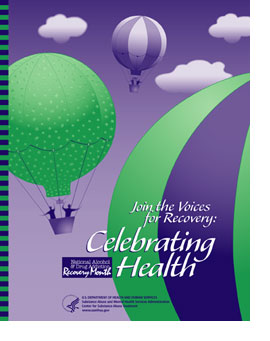
In September 2003, we´ll
celebrate the 14th annual National Alcohol
and Drug Addiction Recovery Month (Recovery Month). The month is
set aside to highlight the strides made in substance abuse treatment,
and to educate the public that addiction is a chronic, but treatable,
public health problem that affects us all.
To address this issue, the Substance Abuse and
Mental Health Services Administration´s (SAMHSA) Center for Substance
Abuse Treatment (CSAT), within the U.S. Department of Health and
Human Services (HHS), in conjunction with its national planning
partner organizations and treatment providers, has created this
comprehensive user-friendly toolkit.
The kit helps you deliver the message that recovery
from drug and alcohol addiction can become a reality by utilizing
accredited professionals and programs, family support, and peer
help services. It allows you to easily tailor a community outreach
program to match your time and resources, and to help you educate
key community constituent groups.
This year´s kit focuses on substance abuse disorders,
co-occurring disorders, and
co-existing disorders. Substance abuse disorders refers to alcohol abuse
as well as use or misuse, dependence, and addiction to legal or illegal
drugs. Co-occurring disorders occur when a mental disorder and alcohol
and/or drug addiction are present in a person simultaneously. This issue
is of major importance, and in late 2002, SAMHSA published a Report
to Congress on the Prevention and Treatment of Co-occurring Substance
Abuse Disorders and Mental Disorders, outlining the human, social,
and economic costs of co-occurring disorders, and the toll they take on
families, communities, and the nation. Co-existing disorders occur when
a substance abuse disorder is accompanied by other conditions, both medical
and social, such as cognitive, developmental, and physical disabilities,
HIV/AIDS, alcohol-related birth defects, chronic homelessness, hepatitis
C, hypertension, heart disease, and diabetes. Both co-occurring and
co-existing disorders can complicate treatment.
This year’s theme, “Join
the Voices for Recovery: Celebrating Health,” encourages
everyone to help incorporate community treatment and recovery services
as an integral part of the public health system. Implementing an
effective Recovery Month campaign
takes only six simple steps.
| 1. |
Read through the kit and familiarize yourself
with its contents. |
| 2. |
Select two or three key constituent groups
in your community to target. |
| 3. |
Select activities to accomplish your objectives. |
| 4. |
Plan and execute the activities you selected. |
| 5. |
Post your event on the official Recovery
Month web site at
http://www.recoverymonth.gov. |
| 6. |
Complete and return the Customer Satisfaction
Form (see Resources) and share the success of your campaign
and the lessons learned from it. |
Whether this is your first Recovery
Month campaign or you are building on past efforts, the kit provides
everything you need, including: materials tailored to key constituent
groups with concrete steps for improving treatment and recovery, templates
that you can customize, and suggestions for informing your community about
treatment and recovery success stories.
If you would like to order additional kits free-of-charge
or download PDF versions of the kit, visit http://www.recoverymonth.gov,
or call SAMHSA’s National Clearinghouse for Alcohol and Drug Information
(NCADI) at 1-800-729-6686 or
1-800-487-4889 (TDD). The web site also provides additional planning resources,
media updates and alerts, web events, and an official record of national
activities.
| |

| |
|
|
| |

Select two or three media communiques
from the samples provided to broaden awareness that substance
abuse treatment needs everyone’s involvement to make
it work in your community.
Sample
Media Advisory—A
one-page media alert about an event you want local press to
cover. This sample illustrates the format, basic information
to include, and suggests methods of distribution.
Sample
Press Release—A guide
for your own releases about special activities your organization
is planning to promote Recovery
Month.
Sample Op-Ed—An
opportunity to express a strong opinion on a particular issue.
Tailor this sample to your needs, or use it as a guide for
your own article.
Sample Proclamations—Two
different versions that allow you to tailor a proclamation
that can be issued by mayors, governors, or other leaders
to promote and encourage support of Recovery
Month in your community.
Promotional Event
Ideas—Suggestions to publicize
and commemorate Recovery
Month.
Radio
PSA Scripts—Announcer-read
public service announcement scripts promoting Recovery
Month that can result in
free air time.
Logo
Sheet—Camera-ready artwork
of the official logo for Recovery
Month is provided for customization
of your materials.
Letterhead—Camera-ready
artwork to copy for your Recovery
Month-related correspondence.

Select key constituent groups
to help you promote substance abuse treatment services
in your community. Use the fact sheet designed for that
audience—or
a combination of fact sheets—to create an information
packet to disseminate.
At the end of each fact sheet are suggested action steps
to help your audience
start or expand their involvement. Also included are
statistics, examples of
success stories, and resources to help you promote
National Alcohol and Drug Addiction Recovery Month.

Planning Partners—A
comprehensive list of organizations that are participating
in planning this year’s National
Alcohol and Drug Addiction Recovery Month
observance.

Additional
Resources—A list of relevant
substance abuse treatment-related clearinghouses and resource
centers; Internet addresses of online web sites; and pertinent
national organization addresses, telephone numbers, and web
sites.
Single
State Agency Directory—State
drug and alcohol abuse office contacts for local information
and support.
Customer
Satisfaction Form—Please
share your reactions to this year's kit and the initiatives
you implemented in your community. Directions are provided
on the form.
|
|
| |
|
|
|
|
|





